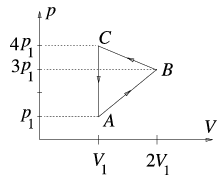Exercises and problems in Physics
February 2002
Please read The Conditions of the Problem Solving Competition.
 |
Experimental problem |
M. 230. Take a chain made up of identical links. (It could be like the one we have recently decorated the Christmas tree with.) Determine the values of the coefficients of a) static and b) kinetic friction between the chain and the surface of a table. (6 points)
 |
Theoretical problems |
P. 3488. A solid, straight cylinder standing on its base is sliding down a slope of a given angle. The coefficient of friction is \(\displaystyle mu\). Which point of the cylinder's base can be considered as the work point of the pressing force exerted by the slope? (4 points)
P. 3489. A snowball of a mass of 150 g hits a window pane at a velocity of 20 m/s and stops within 0.01 s. Will the pane break if it can resist a maximum of 300 N pressing force at the site of the hit? (4 points)
P. 3490. Why is it that some helicopters need a tail-rotor and others do not? (3 points)
P. 3491. The pull force of an electric motor is 310 kN at a speed of 57.6 km/h. The supply voltage is 3.6 kV and there is an electric current of 230 A in the coils of the eight electric motors. Determine the efficiency of the motor. (3 points)
P. 3492. What is the radius of a bubble that has formed from a detergent solution, and in which the density of air is one thousandth higher than the air surrounding it. (4 points)
P. 3493. We make hydrogen gas undergo the ABCA thermal cycle shown in the figure. (p1=2.105 Pa, V1=2 m3, TA=300 K.)

a) How much heat is transmitted to the gas during the different subprocesses?
b) What is the total amount of work performed on the gas? (4 points)
P. 3494. What is the radius of the imaginary concentric sphere that divides the electrostatic field of a metal sphere of a radius of 20 cm and a charge of 8.10-7 C into two regions of identical energy? What is the total energy of the electric field of the metal sphere? (5 points)
P. 3495. The flat surface of a hemispherical glass lens is mat (n=1.5, R=4.8 cm). There is a point source of light on the axis of symmetry of the hemisphere. The incident light creates a bright spot on the mat surface. Where is the light source when the spot of light is the smallest? What is the diameter of the spot in this case? (5 points)
P. 3496. \(\displaystyle lambda\)min denotes the shortest wavelength of the light emitted by a hydrogen atom. Can this atom emit a photon of a wavelength of \(\displaystyle 2\lambda_{\min}\)? (4 points)
P. 3497. We divert a string pendulum of a length of 1 meter until it is horizontal, then let it fall. What is the angular velocity of the acceleration vector of the body hanging at the end of the string when the acceleration vector is a) vertical, b) horizontal? (6 points)
Send your solutions to the following address:
- KöMaL Szerkesztőség (KöMaL feladatok),
Budapest 112, Pf. 32. 1518, Hungary
